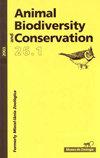拟龙葵的系统发育研究(腹足目:龙葵科):一个新单倍群的鉴定
IF 1
4区 环境科学与生态学
Q3 BIODIVERSITY CONSERVATION
引用次数: 0
摘要
陆地蜗牛Elona quimperiana被列入《欧洲栖息地指令》附件二和附件四。在本研究中,基于两个mtDNA基因片段(COI和16S rRNA)和一个nDNA基因片段的测序,从其整个分布范围重建了该保护物种种群之间的系统发育关系。COI和16S rRNA基因片段也产生了单倍型网络。结果产生了三个主要的种内门群,这里被指定为布列塔尼-西班牙、巴斯克和纳瓦拉-里奥哈谱系。这最后一个谱系以前没有被发现。三个主要门群之间的遗传距离表明,它们可能起源于最后一次冰川盛期之前的异父分裂,然后在伊比利亚半岛的三个避难所分别进化。我们在这里提出,每个门群都被认为是一个进化重要单元。通过扩大采样,我们能够确定所有三个谱系的地理分布。我们的基因结果支持了该物种在冰川后从伊比利亚半岛东北部到法国西北部布列塔尼的殖民,并排除了其最近的人类引入。本文章由计算机程序翻译,如有差异,请以英文原文为准。
Phylogenetic study of Elona quimperiana (Gastropoda: Elonidae): identification of a new haplogroup
The land snail Elona quimperiana is listed in annexes II and IV of the Europe Habitats Directive. In this study, phylogenetic relationships between populations of this protected species from its whole distribution range were reconstructed based on the sequencing of two mtDNA gene fragments (COI and 16S rRNA) and one nDNA gene fragment (ITS2). Haplotype networks were also generated for the COI and 16S rRNA gene fragments. Results yielded three main intraspecific phylogroups, here designated as the lineages Brittany-Spain, Basque, and Navarre-Rioja. This last lineage had not been identified previously. Genetic distances between the three main phylogroups suggest they could have originated by allopatric fragmentation before the Last Glacial Maximum, and then separately evolved in three refugia in the Iberian Peninsula. We here propose that each phylogroup is considered an Evolutionarily Significant Unit. Through extended sampling, we were able to delimit the geographic distribution of all three lineages. Our genetic results support post-glacial colonization of this species from the north-eastern Iberian Peninsula to Brittany in NW-France as proposed previously, and rule out its recent anthropic introduction.
求助全文
通过发布文献求助,成功后即可免费获取论文全文。
去求助
来源期刊

Animal Biodiversity and Conservation
农林科学-动物学
CiteScore
2.00
自引率
0.00%
发文量
21
审稿时长
>12 weeks
期刊介绍:
Animal Biodiversity and Conservation (antes Miscel·lània Zoològica) es una revista interdisciplinar, publicada desde 1958 por el Museu de Ciències Naturals de Barcelona. Incluye artículos de investigación empírica y teórica en todas las áreas de la zoología (sistemática, taxonomía, morfología, biogeografía, ecología, etología, fisiología y genética) procedentes de todas las regiones del mundo. La revista presta especial interés a los estudios que planteen un problema nuevo o introduzcan un tema nuevo, con hipòtesis y prediccions claras, y a los trabajos que de una manera u otra tengan relevancia en la biología de la conservación. No se publicaran artículos puramente descriptivos, o artículos faunísticos o corológicos en los que se describa la distribución en el espacio o en el tiempo de los organismes zoológicos.
 求助内容:
求助内容: 应助结果提醒方式:
应助结果提醒方式:


